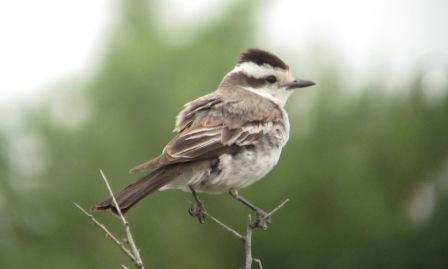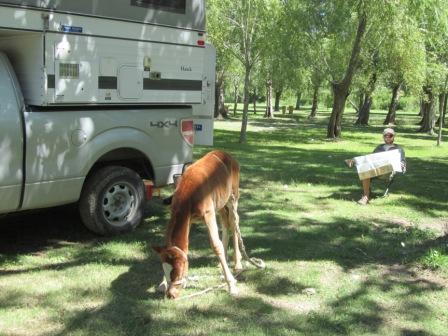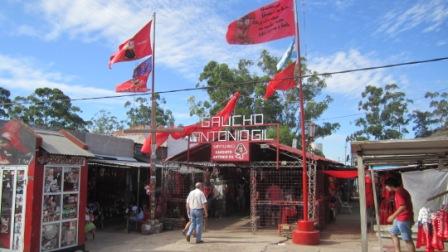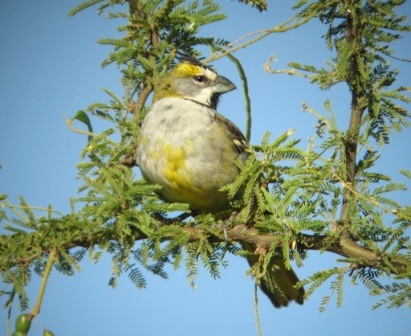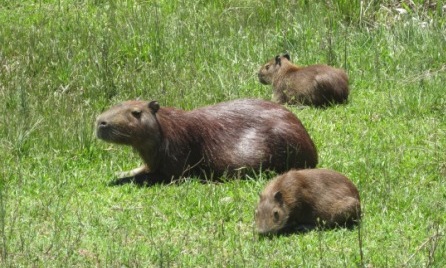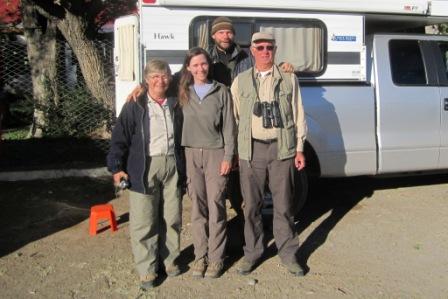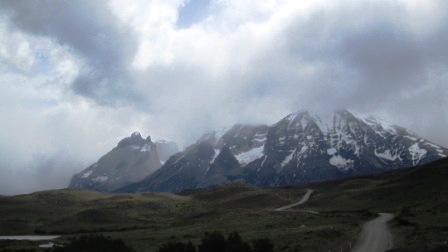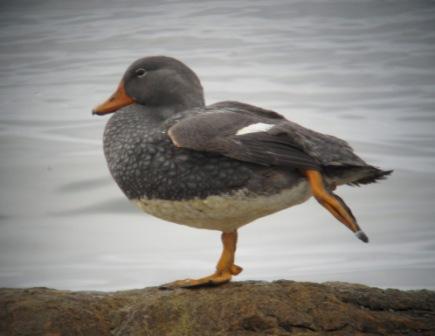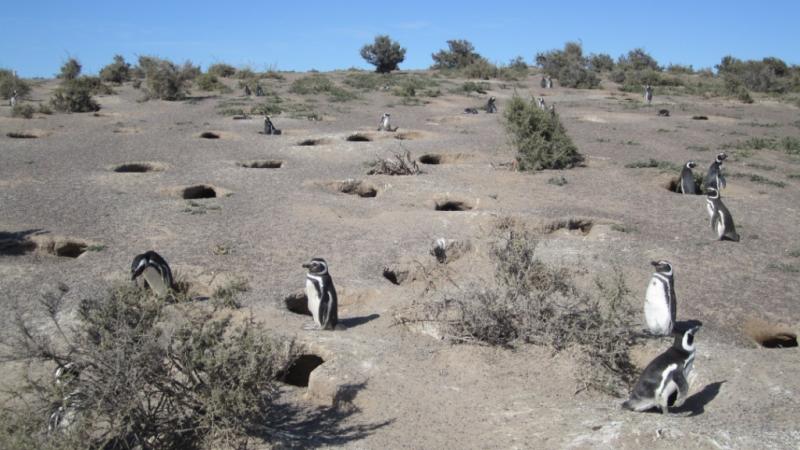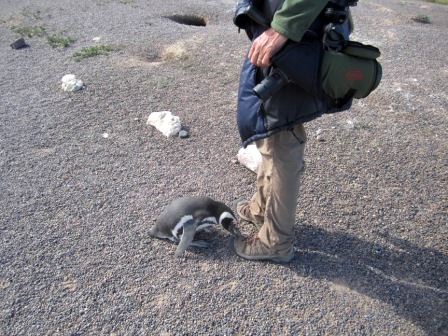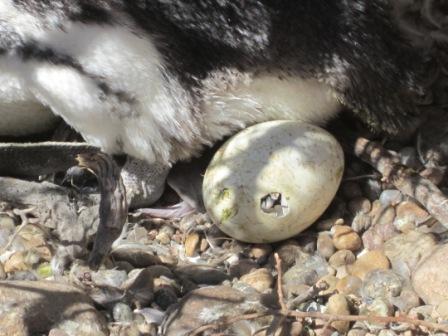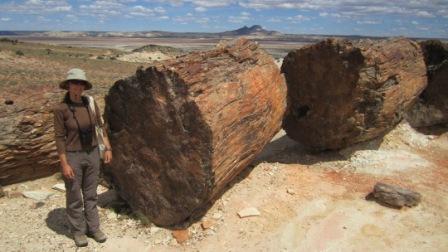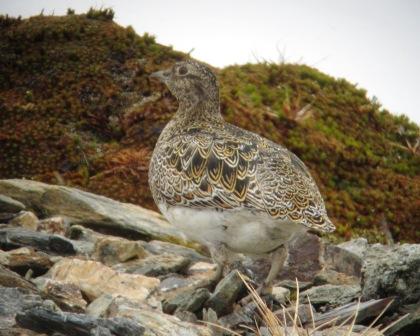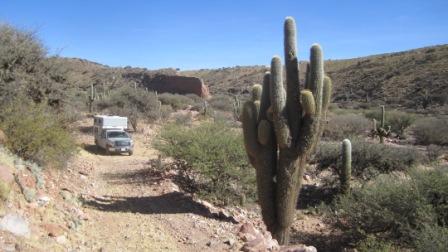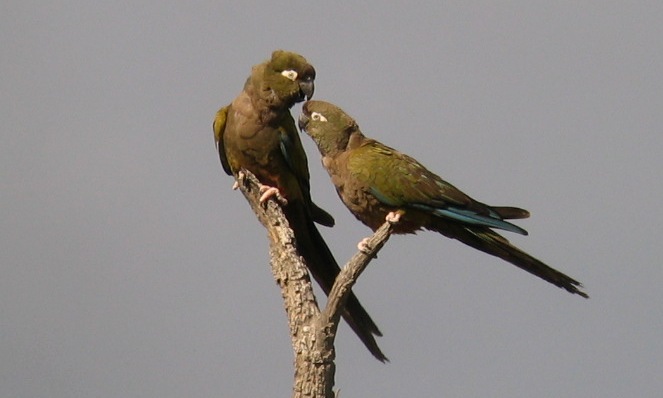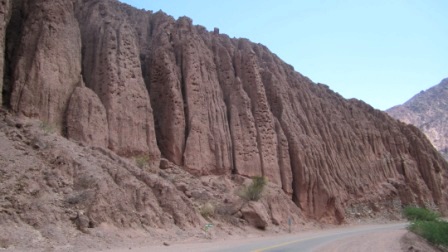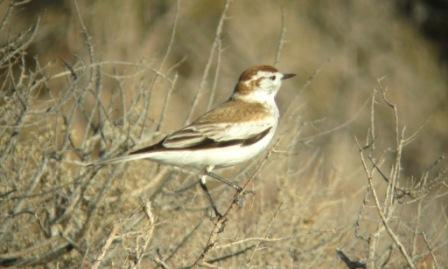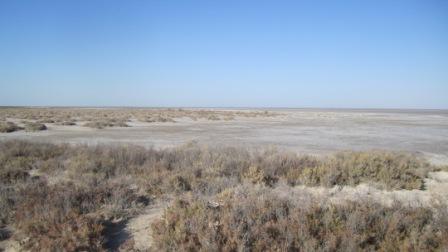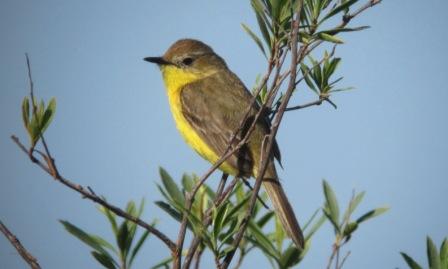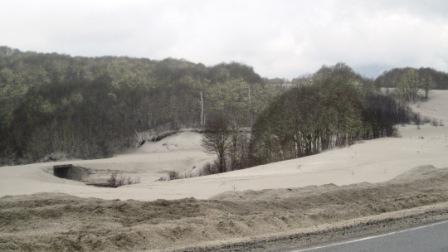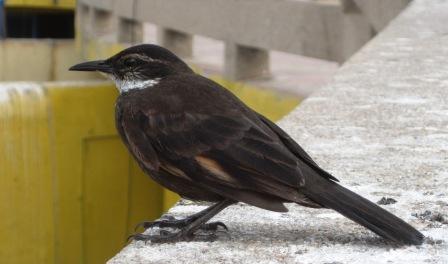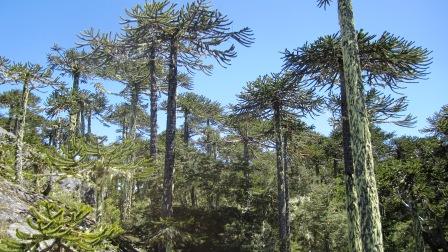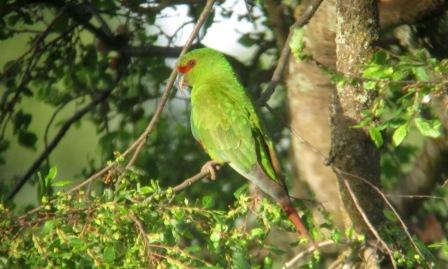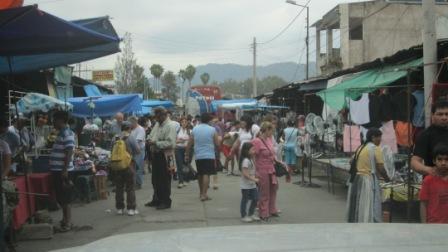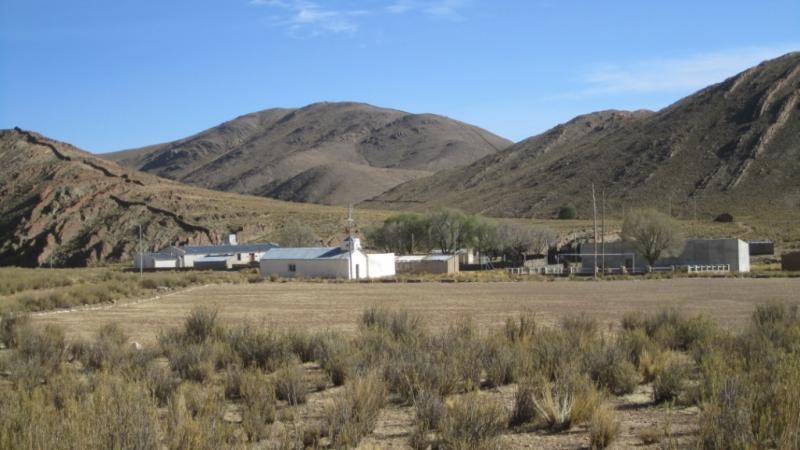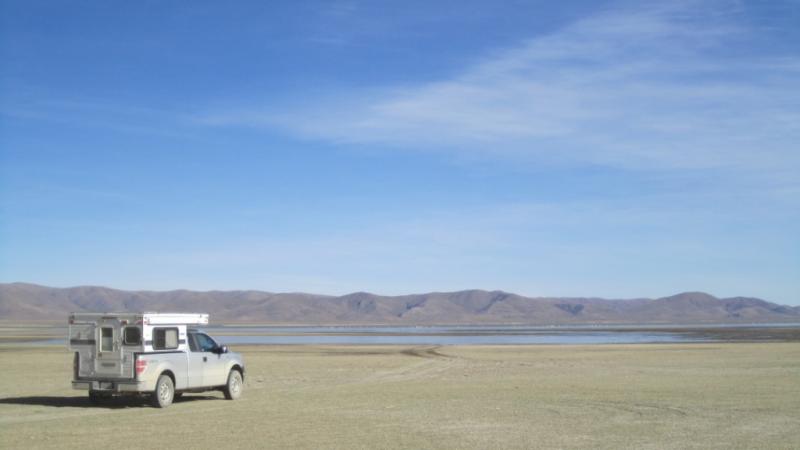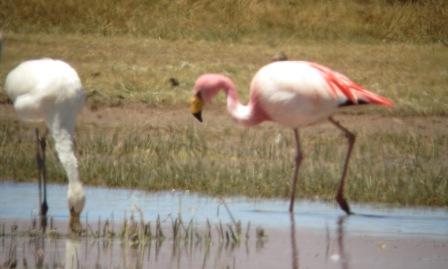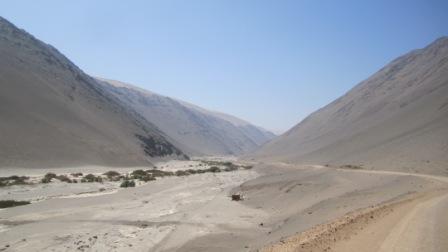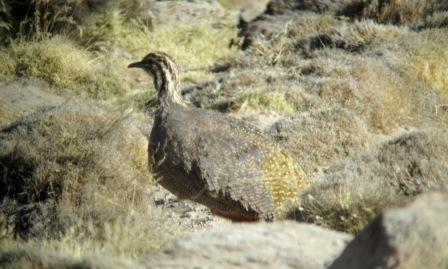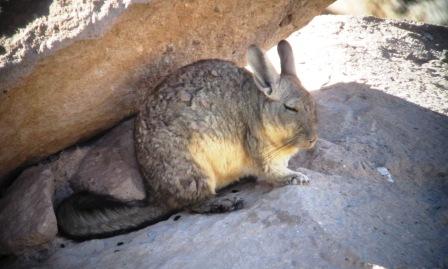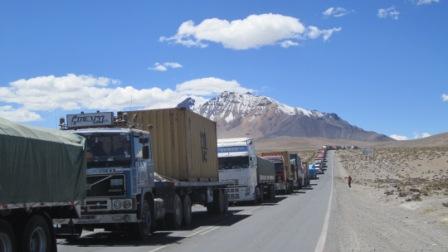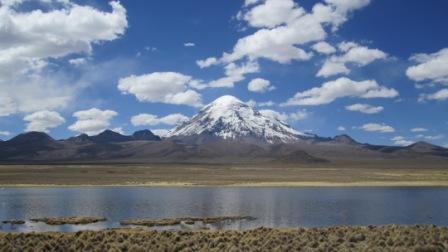calyptura.com
Jon and Anne's birding travels
blog2
Giant rodents and Argentina's Robin Hood: the north-east
Posted 8th January 2012
We write this from a strange location for us, a lovely top floor hotel room overlooking the Atlantic in downtown Montevideo, Uruguay. Well, we had to wait somewhere while Anne’s Brasil visa was being processed, and having birded on throughout Christmas and New Year, we decided we could relax for a couple of days.
We wrapped up two-and-a-half great months in Argentina with a couple of weeks in the north-east. Although much more populous, developed, and agricultural than the rest of the country, there are still many interesting places to visit and birds to look for in this region. We found many great species including Strange-tailed Tyrant, five species of scarce seedeaters, both Straight-billed and Curve-billed reedhaunters, Red-and-white and Rufous-sided crakes, Pampas Meadowlark, and several spinetails, among other goodies. We look forward to returning to extreme north-east Argentina later in 2012 when we visit the famous Iguazu Falls (in the austral winter, a time more suitable for birding).
Black-crowned Monjita, near Las Grutas, Rio Negro province, 11th December 2011. Once we finally tracked down a good area for this species, we found several of them, and even an active nest with chicks (apparently one of only a handful of nests described for the species).
We spent an interesting Christmas on the shore of the Rio de la Plata, just east of Buenos Aires, at a relaxing camping area that just happened to have ensuite Red-and-white Crakes. This is the time of year when Argentines flock to the beaches, and they showed up in force Christmas morning. Fortunately, it was not too chaotic and we very much enjoyed observing how the locals spend the holiday. Our next door neighbors were two local families that came down to set up stalls selling everything you might want at the beach, such as inflatable rafts, sunglasses, hats, and wine. Most amusing was that they brought their orphaned foal with them, which grazed freely about the area, including between Jon (dutifully studying a Brasil map) and our truck.
Driving throughout Argentina you frequently see small roadside shrines adorned in red flags and other offerings, often one every few kilometres. It wasn’t until we reached the northeast that we discovered the full story behind them. Legend has it that a gaucho named Antonio Gil was an Argentine outlaw in the late 1800s who acquired a reputation as a Robin Hood figure for his efforts to protect and help the needy (like Robin Hood, parts of his story hover between myth and fact). When he was eventually captured and a policeman was about to kill him, Gil said to him: "Your son is very ill. If you pray and beg me to save your child, I promise you that he will live. If not, he will die". After the policeman killed Gil anyway, he learned that his child was in fact gravely ill. The policeman prayed to Gauchito Gil and his son miraculously recovered. Very grateful, the policeman gave Gil's body a proper burial, built a tiny shrine to him, and tried to let everybody know that Gauchito Gill had cured his son.
Since then, the original shrine has become a large sanctuary surrounded by stalls selling offerings, good luck charms, other souvenirs, and food. As we were passing within a few kms, we went to see the sanctuary (shown above), located near Mercedes in Corrientes province. As seems often to be the case in Catholic countries, this character has become a folk saint for many people in Argentina, and they visit the sanctuary to ask for favors. For reasons that seem obscure, at some point Gil transitioned into a sort of patron saint of drivers, hence the roadside shrines, and many vehicles have a strip of red cloth attached to them hoping that Gil will keep them safe on the roads. The shrine was adorned with little plaques with car licence plate numbers, which people leave hoping to improve their chances on the roads. There is even a campground adjacent to the shrine for pilgrimages and the annual celebration on the date of his death. The Catholic Church hasn't declared Gauchito Gil a saint, indeed his story has no real religious history, but many Argentine people seem to treat him as such.
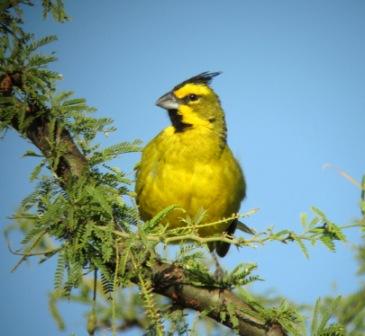
Yellow Cardinal (male left, female right), Reserva Nacional Ibera, 29th December 2011. Having been common and widespread in parts of Argentina, Uruguay, and southern Brasil several decades ago, the population of this beautiful species was estimated at fewer than 3000 birds in 2007. Its striking appearance, combined with a pleasant song, have made it a favourite in the cagebird trade, and populations have collapsed under relentless trapping. We failed to find it at well known sites where birders still saw it in the early 2000s, and have since heard that it has not been seen there recently, but we got lucky at Ibera where a small population persists. On its current trajectory, it seems likely that Yellow Cardinal will become extinct in the wild in our lifetimes.
We had both long wanted to see capybaras, and Ibera did not disappoint for these. We saw numerous individuals and small groups, including lots of young ones, wallowing in mud pits near the roadside. The capybara is the largest living rodent in the world. Its common name, derived from Kapiÿva in the indigenous Guarani language, means "master of the grasses". They reminded Jon somewhat of small furry hippos, with nostrils, eyes and ears all at the top of the head. Despite all of the amazing birds we’ve seen on our travels, for Anne this was a highlight of the trip so far.
Southern swing: Patagonia and Tierra del Fuego
Posted 8th January 2012
We spent November and December working our way south through western Patagonia (Argentina's famous Ruta 40, plus ducking in and out of parts of southernmost Chile), down to Tierra del Fuego, then back up north along the Atlantic coast. We moved faster than normal, partly due to the lower number of birds in the region, but largely due to the cold weather which discouraged pausing too long in any one spot. Although we previously posted photos of arguably the two best birds of this part of the expedition (see "We made it!" below), here are a few more images of scenery, birds, and other things from that period.
When we stopped for a night at Estancia La Angostura in southern Patagonian Argentina - the best site for Austral Rail - we were told a bird tour would also be staying for the night. You can imagine how shocked, then elated, we were a couple of hours later when out of the tour minibus emerged our dear English friends Martyn and Veronica Bailey. They knew we were in Argentina of course, but understandably assumed we would be hundreds (or thousands) of kms away. Given that we and they were only staying in that one spot for one night, we had bizarre luck to be there at the same time. But this sort of thing keeps happening with the four of us: we originally met on a boat trip off Sydney, Australia about ten years ago, then lost touch but ran into each other again by complete chance at a lodge in Brasil four years later. Where on Earth will we meet up next time....!
We do go out of our way to see things other than birds every once in a while. A visit to the Perito Merino Glacier in Parque Nacional Los Glaciares (Argentina) is well worth it - a truly spectacular experience of sight and sound. We were lucky to see a chunk of ice the size of a car calve into the water and enjoyed all of the creaking sounds generated by the very active glacier. And yes, the ice really is that blue.
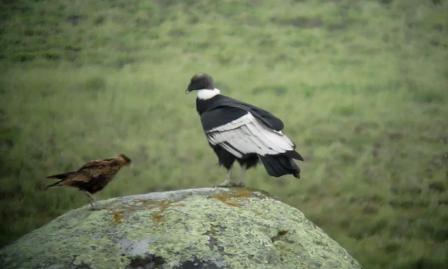
Even non-birding side trips produce birds. Although we had seen them in many places and five countries, Andean Condors were especially common in P. N. Los Glaciares. For reference the small bird to the left is an immature Southern Caracara, a raptor roughly the size (for North American readers) of a Red-tailed Hawk or (for British readers) a Common Buzzard. Incredibly when it later flew, we both thought we saw the condor shed a flight feather as part of its normal moult. Jon ran over to the spot and wehave become the proud owners of an amazing, curved, two-feet-long condor outer primary feather. The feather itself is bigger than most of the birds we have seen on these travels.
We had fairly good weather in the mountainous far south, where snow, rain, and gale-force winds can be common even in summer. We actually saw several of the peaks as we entered Parque Nacional Torres del Paine (Chile), which were then completely obscured for the rest of our time in the park. We met folks who had been there for a week and seen nothing but thick mist, so we were fortunate.
A Flightless (or Fuegian) Steamer Duck practicing some yoga, just south of Punta Arenas, Chile. Living in quiet bays in the chilly waters around and near Tierra del Fuego, they decided that flight was overrated, and that being big and chunky to survive the frigid conditions was probably more important (they are the size of a small goose). If they want to get anywhere in a hurry, which they rarely do, they can still use those vestigial wings for splashing their way across the water in the manner of an old style steam ship (hence the name).
We greatly enjoyed the massive, famous Magellanic Penguin colony at Punto Tombo on the southern Argentine coast. Although neither of us is a fan of close encounters with seemingly tame birds, it was a lot of fun to be so close to these comical birds.
You are asked to keep at least one metre from the penguins, but this individual waddled up to Jon and started molesting his boot before he could get away. Honest.
Small chicks were present in some of the nests and we were especially fortunate to find this one just starting to peck its way out of the egg (its little bill is just visible in the hole).
Another (largely) non-birding side trip, this time to a petrified forest in south-central Argentina. Admittedly Anne is pretty tiny, but the size of the petrified Araucaria (monkey puzzle) logs is still impressive, and accentuated by the barren Patagonian semi-desert environment. These remnants of the vast forest that once covered the area date from the Jurassic and were browsed by giant herbivorous dinosaurs (at least that's what the board in the visitor centre said).
We made it!
Added 29 November 2011
After 19 months and a week, 59,500 km, and 3350 bird species, "Expedition Calyptura" rolled into Ushuaia, southernmost Tierra del Fuego, last night. The end of the road, as it were, for many Panamericana travelers. Barely over the halfway stage of the trip for us! But a big milestone nonetheless. It probably goes without saying that it has been a hugely enjoyable and wildy successful meander south, but having found every species likely down here near the tip of the Southern Cone, we are looking forward to some warmer weather.
No rest for the crazy. We turn north and start heading up the Atlantic coast toward the Valdez Peninsula (and relative warmth) tomorrow.
Rather than the traditional team photo with a backdrop of the snowy peaks of Tierra del Fuego, it seemed appropriate to show photos of a couple of the best birds from recent days. While the diversity of birds is low in southernmost South America compared to all those months in Colombia, Ecuador, Peru, and Bolivia, the quality of individual species is very high, and these two examples are no exception.
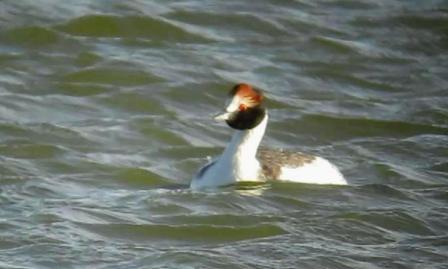
Hooded Grebe (above), Estancia La Angostura, Santa Cruz province, Argentina, 20th November 2011, and White-bellied Seedsnipe (below), above Paso Garibaldi, Tierra del Fuego province, Argentina, 28th November 2011.
The Hooded Grebe - only discovered in 1974, such was the remoteness of interior Patagonia - is declining so rapidly that its extinction has been predicted well within our lifetimes. So little is really known about the species that the causes of its decline are unclear, and its true population is uncertain, but the seven birds we saw could well represent one or several percent of the global population. White-bellied Seedsnipe is thankfully much commoner, but perhaps even harder to see, as it has the irritating habit of living high on the frigid, wind-blown, snow- and scree-covered slopes of mountains in extreme southern Chile and Argentina. Many folks birding the region never get the chance to try properly to see it, as the weather is simply too bad at the known sites. Even those who get the chance to try miss it more often than not. After a steep hike to reach suitable habitat, Jon found this one after over two hours of searching, and was able to watch it for a while before the snow came and he beat a hasty retreat.
Photospot: North-west Argentina
Written early November, posted 30th November 2011
We had an excellent few weeks birding in north-west Argentina, parts of which we described in earlier postings. Jon visited some of this region briefly in 2006, so we focused on sites he wasnt able to visit and returned to a few he had particularly enjoyed then. The weather was lovely - warm and dry - a combination we hadnt encountered very frequently since Mexico. We managed to find virtually all of the regional endemics and enjoyed various habitats and many excellent bush campsites in the process. Before heading into Chile we stopped in Cordoba for an intensive few days to sort out various issues with the vehicle, primarily a new set of tyres and an upgrade to the hard-working rear suspension.
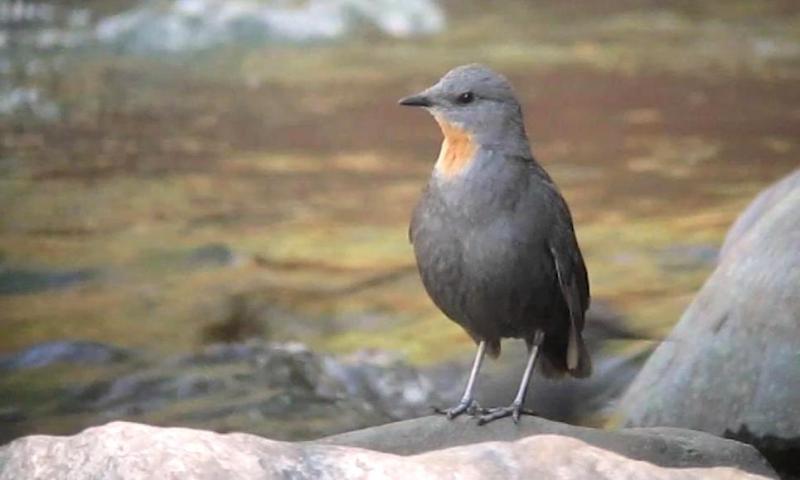
Videograb of Rufous-throated Dipper, near Yala, Jujuy province, 12th October 2011. One of several locations where we found this species, we watched and videoed this pair for a couple of hours nest-building. The last of the Worlds dipper species for Jon.
It would be pretty easy to convince folks this was taken in Arizona, but its actually northwest Argentina, only a few hundred kilometers south of Bolivia.
Not all Latin American parrots live in lush tropical jungles. Burrowing Parrots (above) are found locally in arid habitats of Chile and Argentina where they nest in cliffs. We came upon this colony (see holes in cliff, below) next to the road on our way south from Salta.
Salinas Monjita (above) has one of the most restricted ranges of any bird in South America. It only occurs at the edge of two large salt flat areas in central northwestern Argentina. We were pleased to find at least three individuals at the edge of Salinas Grandes (below) in Cordoba Province.
The delightfully-named Dinelli's Doradito is another northern Argentinian species with a very restricted breeding range (although it disperses into Paraguay in the austral winter). Only a handful of sites are known for the species, and it is generally off the beaten birders circuit.
Photospot: Central Chile
Posted 30th November 2011
Back to cooler climates, and lower bird diversity but great quality. We were fortunate to track down all of the central Chilean endemics and near-endemics during our two weeks here, including the yet-to-be-described "Lemon" Doradito, which has been seen by very few folks to date. (As an aside, this was at least our eighth known-but-not-formally-described bird species we had seen this year.) Other than a couple of days at coastal sites north of Valparaiso, almost all of our time was spent in four national parks and reserves. The park system in Chile is excellent - a good thing as almost all native habitat outside of these areas has been removed. Our last stop along the road back into Argentina was Parque National Puyehue, where there had been a volcanic eruption in June, which famously disrupted air traffic in the southern hemisphere. There was still a lot of ash being blown around and massive deposits of ash, gravel, and pumice over a huge area on both sides of the border.
Appearing to be a snowy winter scene, this is a picture of the deposit - several feet deep in places - of ash and pumice left over from the recent Puyehue volcanic eruption.
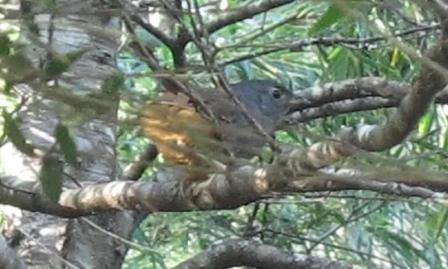
It is not a great videograb, but those of you who have tried to see tapaculos in the field know how difficult they can be to see, let alone photograph. Ochre-flanked Tapaculo is considered by some to be one of the hardest, but at the time of our visit they seemed relatively straightforward, and we enjoyed several seen at three different sites. A testament to our persistence (or growing insanity), this was the 40th species of tapaculo we saw in 2011.
As the name suggests, Chilean Seaside Cinclodes is restricted to rocky shores of Chile. We encountered this individual perched on a wall next to the pavement, at Concon, near Valparaiso. We realised why it was so approachable when the female flew out of a crevice just below in which she was nesting.
We enjoyed a lovely hike through the Araucaria (monkey puzzle) trees at Parque Nacional Nahuelbuta. In additional to the excellent birding, the forest was very impressive, with some massive Araucaria trees estimated at 2000 years old.
Slender-billed Parakeet has a long, thinupper mandible (upper side of the bill)adapted to feeding on Araucaria cones. Although forests within its range have been extensively removed, the species has been able to shift to feeding in tilled agricultural fields and appears not to have suffered serious population decline.
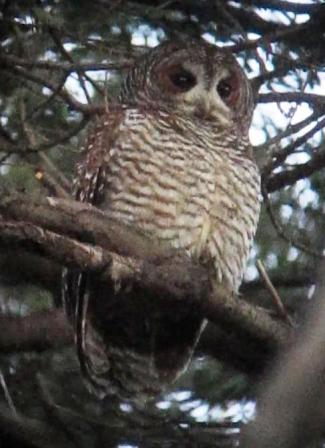
This Rufous-legged Owl and her mate roosted in the trees only a few hundred meters from our campsite in Parque Nacional Altos de Lircay. They made quite a racket every evening when breaking roost which helped us find them amongst the branches. We determined her sex from her paler plumage and deeper call compared to the male.
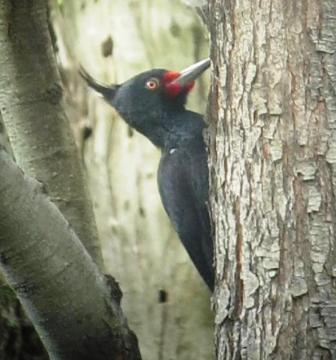
Also common near camp at Altos de Lircay was the impressive Magellanic Woodpecker. A huge woodpecker the size of a crow, the bird pictured is a female (males have entirely red heads). The last of the nine extant members of the genus Campephilus for us to see (the genus that includes the even larger Ivory-billed and Imperial woodpeckers, both presumed extinct).
Into Argentina....eventually
Posted 22nd October 2011
Our departure from Bolivia and first day in northwestern Argentina was a real mixed bag. Despite being the only crossing between these two countries with paved road on both sides, it was a challenge to actually find the border post, because it required negotiating a maze of crowded narrow streets in the border town on the Bolivian side. The confusion was not helped by the fact it was market day and the Argentinians flock to the Bolivian side for cheaper goods - and perhaps coca leaves, illegal in Argentina, for sale in huge drums at most stalls on the Bolivian side - making it rather difficult to drive through the streets.
Having finally made it to the border, we discovered several bus loads of people in the immigration line. So we split up, with Jon going to take care of the vehicle paperwork and Anne waiting in the immigration line. In the end, we were pleased to get through all the necessary steps and be ready to go in under two hours, much faster than we had been led to believe by a guidebook. But our joy did not last long as we returned to find our vehicle had been wheel-clamped! Because of the limited space and line of buses, we didn't have many parking options, but apparently our choice wasn't acceptable. As it was almost lunchtime, we didn't have high hopes of getting the wheel boot removed anytime soon, and we feared a steep fine given the opportunity to take advantage of the gringos in a difficult situation. So we were very pleasantly surprised when Jon was able to get a municipal official he found on the street to call and get someone to come down to collect our fine and remove the boot. Best of all, they didn't even seem to contemplate trying to charge more than the normal $4 fine. At that price, we weren't interested in arguing the merits of the parking situation, but just happy to get rolling and across the border.
The main two-lane road across the Bolivian-Argentinian border at Yacuiba, but you could be fooled into thinking it was a street market (we were).
Feeling good again, we headed south to Parque Nacional Calilegua. Things couldn't have been better by the time we made our way up the dirt road to a ranger station in the middle elevations of the park. There is an official campground lower down, but the very nice ranger allowed us to park next to his house instead, as the species we were seeking were in the upper section of the park. Our pleasure was significantly dampened, however, when we discovered there was a major problem with our camper battery charging system. Our battery charge was low when we had headed out in the morning, because the fridge had been running so much in the heat of the chaco and we had not driven much in several days, limiting re-charging time. So we were dismayed to find that the battery charge had not improved at all during our several hours of driving and there was no power getting from the alternator to the camper batteries when the vehicle was running. Jon's checking of connections, fuses, etc. didn't reveal any easy fixes, so we were going to need an auto electrician to help us out. Unfortunately, it was Saturday, and the ranger informed us Monday was a holiday, meaning it would be two and a half days before we could get anyone to look at it. Ugh! So we decided to just enjoy the great birding at Calilegua until Tuesday morning, and the park was fortunately cool enough that we could switch the fridge off overnight to save what little power remained.
Our friendly park ranger even recommended an auto electrician in the nearest town to the park, so Tuesday morning we were there early. He went through the same steps as Jon, and quickly narrowed the problem down to the battery separator, as we had started to suspect. This device prevents the camper electrical system pulling charge from the vehicle battery, thus avoiding us ever having a flat truck battery. However it had apparently overheated and failed in the opposite direction, i.e. the charge from the alternator while we were moving wasn't making it through to the camper batteries. Our excellent auto electrician quickly had us on the road with a bridge that circumvented the faulty separator, allowing charge into the camper (but now we have to hook and unhook the wire manually from the truck battery every time we start and stop, respectively). Nevertheless, we were up and running again, and happy to push on to the altiplano of the far north-west of Argentina.
The story doesn't quite end there. In the process of trying to buy a new separator online, we found a website that indicated our device had been subject to a recall due to a spate of failures...especially overheating, exactly what our electrician had suspected was the problem. With a little more time online, we quickly found that our serial number fell within the recall, and we have since heard by email from the company that they will courier a new separator to us, all expenses paid of course. On the plus side, apparently in some rare cases the fault resulted in a fire, so we got off easy....
Think pink: Laguna de los Pozuelos
Posted 22nd October 2011
Our main interest at this remote salt lake in extreme north-west Argentina was Horned Coot, the rarest and most localised of the coots, found only in remote altiplano lakes at the junction of the borders of Chile, Bolivia, and Argentina, although it is rarely seen in the latter. The birds are occasionally found at a little lake (Lagunilla de Pozuelos) a few kms west of the huge main lake. On the evening of 13th October, after a long drive up from Jujuy, we were elated to quickly find just two individuals on the rapidly drying pan, in a howling bitter wind.
As dusk was setting in, we looked for a place to camp, and the only realistic option was on the leeside of the largest building in the tiny, remote, dusty mountain pueblo of Lagunillas, between the coot and main lakes. At first the village appeared to be deserted, but then a few young boys emerged and watched us from afar. As we usually do on the infrequent occasions that we camp in or near villages, Jon wandered over to try to seek permission to park for the night (no-one has ever said no in such situations anywhere in Latin America, but we always try to ask).
Apparently the sight of Jon approaching frightened all the boys, who started running back to a building that we soon realised was the school, but he was able to break the ice by tossing them some new tennis balls. Jon eventually got the boys to tell him where he could find an adult and he spoke with the amiable old school principal who said there was no problem with us parking for the night. It was perfect because Jon had taken some of the school supplies (notepads, pencils, and crayons, along with the tennis balls) that we carry to give to children most in need. Although we were in Argentina, nominally one of the more developed South American countries, this is a remote and relatively poor region, 2000 km from the capital Buenos Aires, and with little separating it - geographically or economically - from Bolivia. What we have dubbed "tennis ball diplomacy" has worked well for us, and hopefully for the recipients, in a few similar situations on our travels. From running away scared on our arrival, half-an-hour later the village boys were crowded around the back of the camper asking questions and just plain staring at the strange gringos in their midst, clearly something very rarely seen in these parts. Great stuff.
All ten buildings of the village of Lagunillas. We camped in the lee of the wall at the far right edge of the photo. The only people we found were in the school building at the far left end. Every pueblo in Argentina, no matter how small or basic, has a full size soccer pitch (the cleared area in the foreground).
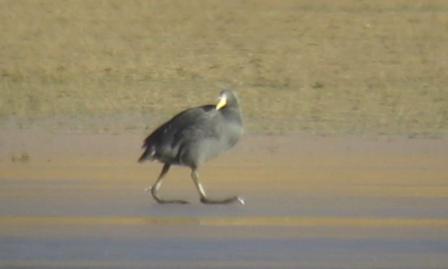
Horned Coot walking on ice on Lagunilla de Pozuelos. The distinctive black horn that hangs over the top of its bill and gives the coot it's name is barely visible in this poor photo. Note the oversize body and truly massive feet.
The other key bird in the area was Andean Flamingo. We had searched for this species at many possible sites it was known to theoretically occur en route without success: all of its possible locations in southern Peru, and in Parque Nacional Lauca in northernmost Chile. We had met other birders who had failed to find it in central Bolivia a week before we passed through the area, so we knew they were not there either.
Now we know why. As soon as could see the saline Laguna de Pozuelos, we stopped and scanned, and even from many kilometres away, we could see huge blobs of bright pink all over the lake - big flocks of flamingos in the heat haze, thousands and thousands of them. All the Andean Flamingos were here, almost literally. Over the next two days we stayed around the lake enjoying the amazing spectacle of so many birds in one place. With some repeated scan counts, we estimated at least 50,000-60,000 flamingos on the lake. Incredible! And in the few close views we could get of some flocks, the majority were Andean, with some James' Flamingo (another scarce altiplano specialist) mixed in.
Given that the current estimate for the global population of Andean Flamingo is 32,000 birds, it seems that more-or-less the entire World population of the species was on this one lake - fortunately for us just when we happened to be visiting. The species is not known to breed at Pozuelos, so presumably conditions just happened to be perfect for feeding, attracting tens of thousands of flamingos to congregate. It was like similar events (with different flamingo species) at the Rift Valley lakes in East Africa, only a few dozen degrees colder, and with no-one else around to witness the event but us.
Laguna de los Pozuelos. We drove as close as we could to see flamingos (as there were tens of thousands of them, they weren't hard to find). Most of the salt lake is very shallow, and although many flamingos were close to the shore,we could see thousands more wadingkilometres offshore.
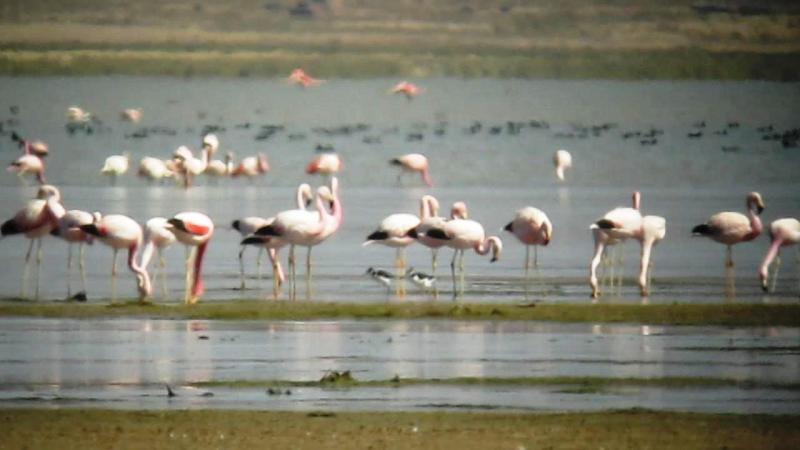
Andean Flamingos. The entire World population may have been on this one lake when we visited. Among other features, the adults are distinguished by their yellowish legs, extensive black on the bill, and large triangle of black on the rear end.
James's (or Puna) Flamingo. Somewhat similar to Andean, but with long vivid pink plumes hanging down over the rear end, pink legs, and more yellow than black on the bill.
Chile (briefly)...and the 1000th new bird!
Posted 20th Sept 2011
From Peru we made a very quick swing through far northern Chile, looking for a few key birds restricted to or easier to see in this region. We started with a drive a short way south in search of Chilean Woodstar, a tiny hummingbird with a similarly miniscule distribution, and were fortunate to find one. It was lucky and appropriate to hit a major landmark with such an endangered and localised bird - our 1000th new bird species since crossing into Mexico on 21st April last year. Our grand total of bird species was up over 2600, but one thousand of those were species we had never seen before. This was a good number in less than a year-and-a-half, especially so for Jon, who had already seen over half the World's birds before we started out. It seemed especially appropriate that it was a hummingbird, as for much of our journey about ten percent of species seen have been hummers.
Stark but stunning Chaca Valley, northern Chile,in which Chilean Woodstar can be found. Natural vegetation is restricted to a narrow strip in the river channel, but we found the woodstar feeding on blossoms in a small citrus orchard on the (dry) river bank.
Then we went east, back into the high Andes and the Parque Nacional de Lauca on the Bolivian border. We spent several days in this area, as there is a lot to see, despite the desolate appearance of the altiplano. We were treated to several key birds, including James Flamingo, White-throated Sierra Finch, and Puna Rhea, as well as several cute mammals. Then it was on to Bolivia...
Puna Tinamou can be a difficult bird to see well but this individual was leisurely feeding in a bofedal (cushion bog) near the road.
A vizcacha dozing in the shade. These rodents are most closely related to chinchillas, but look like a somewhat odd cross between a rabbit and a giant ground squirrel.
The extremely long line - stretching way around the visible corner and beyond - of Bolivian lorries waiting to enter Chile and make their way down to the seaports to pick up their load. Nearly all of Bolivia's shipped imports travel this route, the shortest from the coast to La Paz.
There was yet more spectacular scenery as we crossed into Bolivia and were welcomed by Volcan Sajama, the country's highest peak at 6542m (21590 ft), and the last major peak to be scaled in South America, as (relatively) recently as 1939.
Image copyright notice
All images on this website are subject to copyright (© Jon King, unless otherwise stated). If you wish to use them, whether commercially or non-commercially, please inform Jon by email.
Images appearing on calyptura.com can be used free of charge by individuals and non-profit organisations for strictly non-commercial use. They can be linked or copied to other websites, or downloaded to personal computers. The only exception to this policy concerns non-commercial use of images by any individual or organisation promoting trade in captive birds, or any other activity deemed detrimental to wild birds and their habitats. This use is not permitted.
All other commercial use of images is unauthorized. If you would like to use images for any commercial purpose (i.e. publication in books, magazines, commercial websites, advertisements etc.), or if you are seeking higher resolution scans, slide duplicates or prints, please contact Jon by email.
Jon and Anne's birding travels
